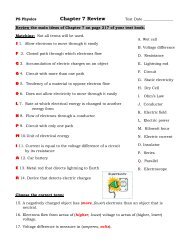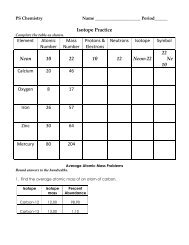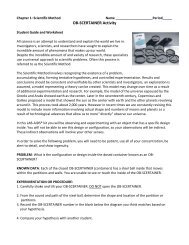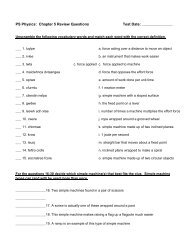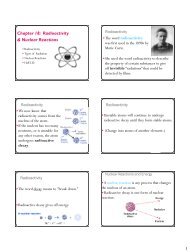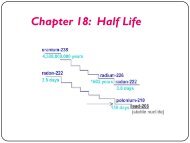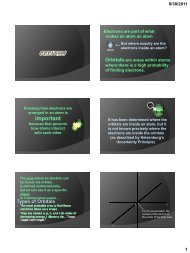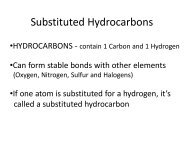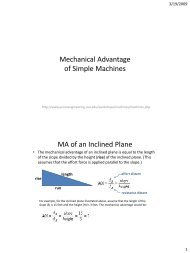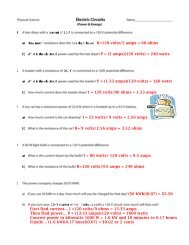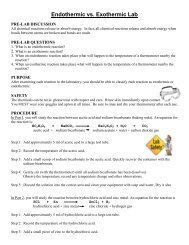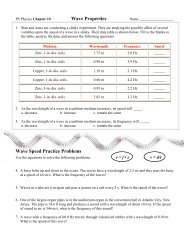Lab 1-1 Kaleidoscope Milk Lab - Shoreline
Lab 1-1 Kaleidoscope Milk Lab - Shoreline
Lab 1-1 Kaleidoscope Milk Lab - Shoreline
You also want an ePaper? Increase the reach of your titles
YUMPU automatically turns print PDFs into web optimized ePapers that Google loves.
Chemistry I<br />
<strong>Lab</strong> 1-1<br />
<strong>Kaleidoscope</strong> <strong>Milk</strong> <strong>Lab</strong><br />
**Use this information to help you complete your Pre-<strong>Lab</strong> and conduct your experiment in<br />
class.<br />
Background Information<br />
The role of milk in nature is to nourish and provide immunological protection for young<br />
mammals. <strong>Milk</strong> has a very high nutritional value and is a very complex food. <strong>Milk</strong>’s general<br />
composition consists mostly of water with equal parts of fat, protein, and sugars. <strong>Milk</strong> also<br />
contains important vitamins and minerals. <strong>Milk</strong> is classified into different types based upon the<br />
amount of fat. Skim milk contains 0g fat per 250mL serving; 2% milk contains 2g fat per<br />
250mL serving, whole milk contains 8g fat per 250mL serving; half-and-half cream contains 8g<br />
fat per 2T serving. The cream is called half-and-half because it is half cream and half milk.<br />
If raw milk is left to stand, the fat will separate from the milk, rise, and form a cream<br />
layer. To prevent this from happening to the milk you buy at the store, the milk goes through a<br />
process called homogenization. Homogenization of milk breaks up the fat into small fat globules<br />
and spreads them throughout the milk. The fat globules (0.1 to 15 µm in diameter) are basically<br />
suspended in the milk.<br />
<strong>Milk</strong> is a complicated substance made up of many parts that are attracted to some<br />
substances while repelling others. These interactions cause milk to act in an interesting way<br />
when mixed with substances such as dishwashing soap. Soap cleans dishes by breaking up fat or<br />
grease and allowing it to flow in the water down the drain. Food coloring is mostly water with<br />
added dye particles. We will discover an interesting property of milk by mixing different types<br />
of milk (skim, 2%, whole, and half-and-half) with food coloring and dishwashing soap. We will<br />
examine the amount of movement of the milk/food coloring before and after soap is added.<br />
Procedure<br />
1. Place the four petri dishes on your lab table. Use scrap paper to label each dish: skim, 2%,<br />
whole, or half-and-half.<br />
2. Fill each petri dish half full with the appropriate milk.<br />
3. Equally space 4 drops of food coloring (any or all colors) in each dish. Record your<br />
observations of the movement of the food coloring in the milk. How far does the food<br />
coloring spread? Do you notice any other interactions between the milk and food<br />
coloring?<br />
4. Dip a toothpick into the liquid dishwashing detergent. Then, touch the toothpick into the<br />
middle of each dish. Try again with more detergent, touching the milk in different areas.<br />
Record your observations of the food coloring movement when soap was added. How<br />
did the food coloring move? How fast did the food coloring move? What else do you<br />
notice about the interactions between the milk, soap, and food coloring?<br />
5. Pour the used milk down the drain with lots of water. Clean each petri dish with lots of water<br />
and completely dry with paper towels. Return all materials to the tray and completely clean<br />
your lab area. Leave your lab area CLEANER than how you found it! Wash your hands<br />
before leaving lab!!!
Chemistry I<br />
<strong>Lab</strong> 1-1 Report<br />
<strong>Kaleidoscope</strong> <strong>Milk</strong> <strong>Lab</strong><br />
Name<br />
Period<br />
The Pre-<strong>Lab</strong> (Purpose, Pre-<strong>Lab</strong> Questions, Hypothesis, Data Table set-up) is before you plan<br />
to conduct the experiment. Use the Background Information and Procedure (copied on the<br />
back of Discovery 1-1) to help you complete the Pre-<strong>Lab</strong>.<br />
Purpose Statement: What is the purpose of this lab?<br />
Pre-<strong>Lab</strong> Questions:<br />
1. a. What are the major components (ingredients) in milk?<br />
b. What is/are the major component(s) in food coloring?<br />
2. What are the differences between the four types of milk you will test in lab?<br />
3. In your own words, explain the process of homogenization.<br />
4. In your own words, explain how dishwashing soap cleans your dirty dishes.<br />
5. In your own words, briefly (2-3 sentences) explain what you will do in the experiment.<br />
Include what you will test, how you will test it, and the types of observations/measurements<br />
you will make.<br />
Hypothesis:<br />
• Predict what will happen (same movement, more movement, less movement) when you add<br />
the food coloring to the different types of milk. Rank the milks from least to most<br />
movement. Provide an explanation for your prediction.<br />
Rank:<br />
Explanation:<br />
• Predict what will happen (same movement, more movement, less movement) when you place<br />
the soap in the different types of milk. Rank the milks from least to most movement.<br />
Provide an explanation for your prediction.<br />
Rank:<br />
Explanation:
Chemistry I<br />
Data Table:<br />
Look back at the procedure and find the data you will need to record. Create a blank data table<br />
to record your observations for each type of milk. You will record your actual observations<br />
during the lab.<br />
Data Analysis/Conclusion:<br />
1. a. Based on the observations in your data table, rank the types of milk in increasing activity<br />
(least to most movement of food coloring) when the food coloring was added.<br />
b. Was your hypothesis supported or rejected by the data?<br />
c. Describe the difference in the water content of the four kinds of milk to explain any<br />
differences you noted for the different types of milk.<br />
2. a. Based on the observations in your data table, rank the types of milk in increasing activity<br />
(least to most movement of food coloring) when the detergent was added.<br />
b. Was your hypothesis supported or rejected by the data?<br />
c. Describe the difference in the fat content of the four kinds of milk to explain any<br />
differences you noted for the different types of milk.<br />
3. a. Predict the food coloring movement for 1% milk. Explain.<br />
b. Predict the food coloring movement for heavy whipping cream. Explain.<br />
4. Based on the results of your lab, what can you infer about the structures of water, fat, and<br />
soap? (i.e. which have similar structures, which have different structures)



